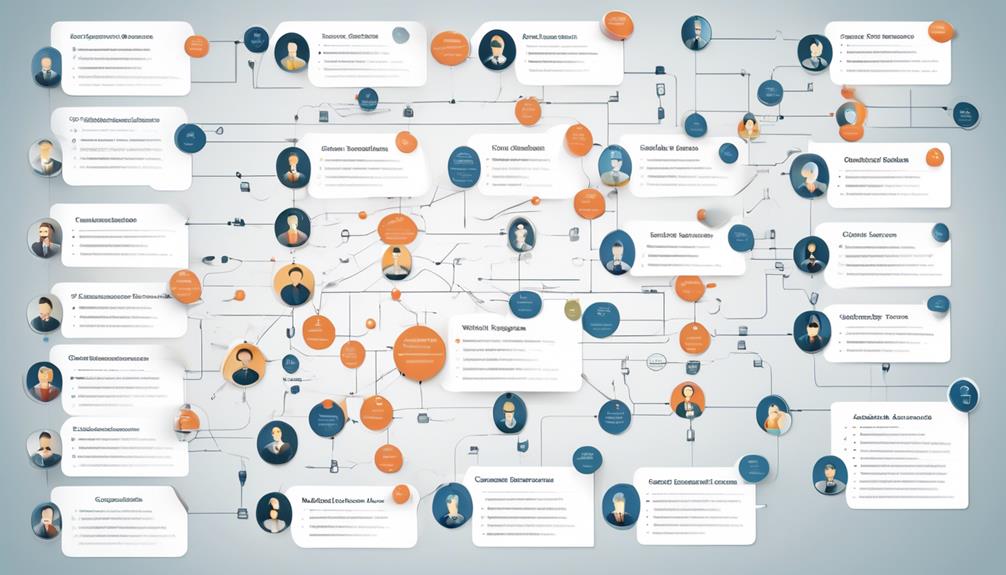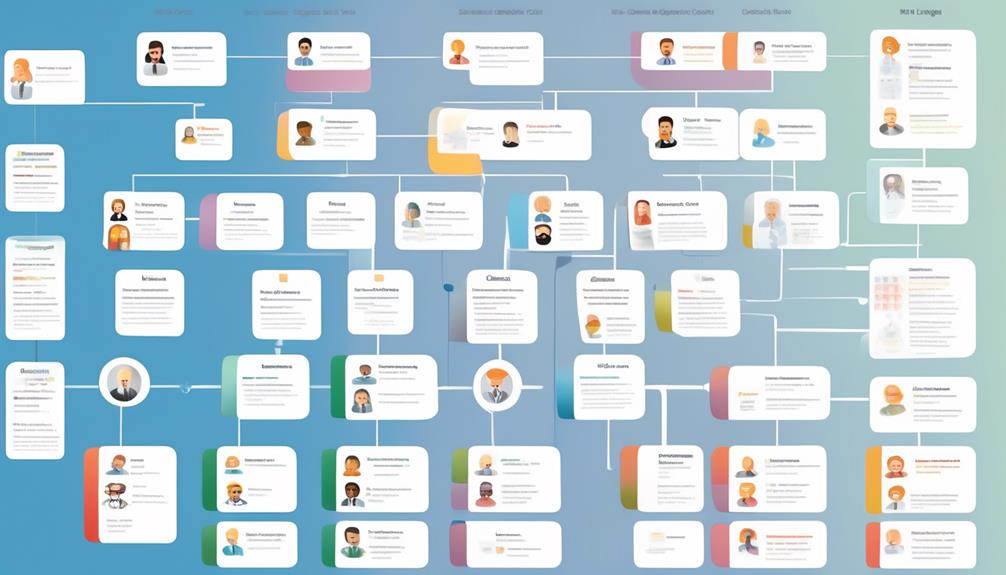When discussing the QA organizational structure in the software industry, there is a degree of intricacy that may not be readily apparent. The configuration of a QA team can significantly impact the efficiency and success of software testing processes.
From the roles and responsibilities within the team to the hierarchical structure, each aspect plays a crucial role in determining the success of the QA team.
Understanding how these elements come together to form an effective organizational structure is essential for any software development organization striving to deliver high-quality products.
Key Takeaways
- The QA team should consist of key roles such as QA Manager/Test Manager, QA Team Lead/Test Lead, QA Architect/Test Architect, Manual QA Engineer/Tester, and Test Automation Engineer/Automation QA Engineer.
- Building a successful QA team requires alignment with the software development life cycle and project requirements, a mix of manual and automation QA engineers, technical QA leads, continuous learning and skill enhancement, and the implementation of robust Test Management tools.
- Obstacles in building a QA team include modifying an existing team, the time-consuming process of finding individuals, developing new communication mechanisms, and dealing with an established approach. However, advantages include the ability to customize the team based on project needs, incorporate specialists with specific expertise, and align the team with project goals and client expectations.
- Effective organization structures for QA teams involve QA Manager/Test Manager leading and managing the team, QA Team Lead/Test Lead supervising team activities, Manual QA Engineers/Testers conducting manual tests, and Test Automation Engineers/Automation QA Engineers performing automated tests.
Key Roles in QA Team
Collaboratively identifying and assigning key roles within the QA team is essential for ensuring a systematic and efficient testing process.
The QA Manager/Test Manager plays a pivotal role in leading and managing the entire team, setting the test strategy, assigning tasks, and auditing the QA process.
Working closely with the QA Manager, the QA Team Lead/Test Lead supervises and coordinates team activities, ensuring the maintenance of test plans and documentation.
The QA Architect/Test Architect is responsible for preparing the test infrastructure, optimizing the testing process, and aligning requirements with resources and competencies.
On the front lines, the Manual QA Engineer/Tester conducts manual tests, analyzes requirements, develops test cases, reports bugs, and verifies software consistency.
Complementing this, the Test Automation Engineer/Automation QA Engineer performs automated tests, builds frameworks, writes and maintains test scripts, and continuously improves the automation framework.
Each role within the QA team is integral to the overall success of the development project, and a clear delineation of responsibilities ensures the effective functioning of the quality assurance team.
Factors for Building QA Team

Considering the importance of a well-structured quality assurance plan and the recruitment of qualified professionals with clearly defined job descriptions and responsibilities, the factors for building a strong QA team are critical for the success of software development projects.
A crucial factor is the alignment of the QA team with the software development life cycle and project requirements. It’s essential to have a mix of manual and automation QA engineers to effectively cover all aspects of software testing. Automation QA engineers play a pivotal role in ensuring efficient and thorough testing, especially in Agile Testing environments.
Moreover, having technical QA leads to oversee the team, establish and monitor testing processes, and provide guidance is indispensable.
Furthermore, fostering an environment for continuous learning and skill enhancement through training programs is vital for the growth and effectiveness of the testing team.
Additionally, implementing robust Test Management tools to streamline testing processes and ensure traceability of requirements is essential for an effective quality assurance process.
Obstacles & Advantages of QA Team
After establishing the factors for building a strong QA team, it’s crucial to address the obstacles and advantages of creating a QA team from scratch. Building a QA team from the ground up presents several challenges, including the time-consuming process of finding and interviewing individuals, and the development of new communication and coordination mechanisms. Modifying an existing team is often easier than forming a new one, and an existing team may already have established approaches and familiarity. However, there are distinct advantages to creating a QA team from scratch. This includes the ability to customize the team based on project requirements, incorporating specialists with specific expertise, and setting team budget, time, and complexity parameters from the start to align with project goals and client expectations.
| Obstacles | Advantages |
|---|---|
| Modifying an existing team is easier | Ability to customize team based on project needs |
| Time-consuming process of finding individuals | Incorporate specialists with specific expertise |
| Development of new communication mechanisms | Set team budget, time, and complexity parameters |
| Existing team has established approach | Align team with project goals and client expectations |
Building a QA team is challenging but essential for maintaining software quality, meeting customer expectations, and beating market competitors. This process, while riddled with obstacles, provides the opportunity to structure a team that best suits the needs of the project and maximizes the potential for success.
Effective Organization Structures

We will outline an effective organizational structure for a software QA team, encompassing key roles and responsibilities to ensure efficient testing processes and high-quality software deliverables.
- QA Manager / Test Manager: These individuals play a pivotal role in leading and managing the team, setting the test strategy, assigning tasks, and auditing the QA process to maintain high standards of quality assurance.
- QA Team Lead / Test Lead: Responsible for supervising team activities, collaborating closely with team members, and maintaining the test plan and documentation, ensuring that testing and quality assurance are conducted in line with best practices.
- Manual QA Engineer / Tester: Conducts manual tests, analyzes requirements, develops test cases, reports bugs, and verifies software consistency.
- Test Automation Engineer / Automation QA Engineer: Performs automated tests, builds frameworks, writes and maintains test scripts, and continuously improves the automation framework to enhance efficiency and effectiveness in testing processes.
Best Practices for Testing Teams
To maximize the effectiveness of testing teams, it’s essential to implement best practices that foster collaboration, systematic processes, and attention to detail throughout the software QA organizational structure.
A basic structure for testing teams should include roles such as Test Automation Engineers, Manual QA Engineers, and QA Managers, each contributing to the quality assurance process.
It’s crucial to establish a clear test strategy that encompasses various types of testing, including functional, non-functional, and performance testing, to ensure the delivery of high-quality software.
Effective communication and collaboration between testing teams, developers, and project managers are imperative for success.
Furthermore, embracing test automation tools and frameworks can significantly enhance the efficiency and accuracy of testing processes.
It’s also important to recognize the differences between production and test environments and their impact on the testing approach.
Frequently Asked Questions
What Is QA Organizational Structure?
Oh, you want to know about QA organizational structure? Well, let’s dive into this intricate web of roles and responsibilities.
From QA Manager to Test Automation Engineer, each position plays a vital part in ensuring the quality of software.
Understanding the difference between production and test environments is crucial.
And don’t even get me started on the integration of machine learning for testing efficiency. It’s a whole world of intricacies!
How Do You Structure a QA Team?
When structuring a QA team, we consider roles like QA Manager, QA Team Lead, Manual QA Engineer, and Test Automation Engineer. Understanding production vs. test environments is crucial.
Integrating machine learning can improve efficiency and predict defects. Test management is vital for proper coverage and defect resolution.
Factors to consider include an effective QA plan, recruiting qualified professionals, and providing training programs. This systematic approach ensures a well-structured and efficient QA team.
Which Parts of an Organization Does QA Work With?
In our role, we work closely with various parts of the organization, including:
- Development teams
- Project managers
- Product management
- Operations teams
- Customer support
This collaboration allows us to:
- Ensure that the software meets quality standards
- Align testing activities with project goals and timelines
- Understand user expectations
- Validate software performance in production environments
- Gather feedback for bug fixes and feature improvements.
How Do You Organize QA Testing?
We organize QA testing by:
- Outlining a comprehensive test strategy
- Setting clear objectives
- Assigning tasks
- Establishing a systematic approach to quality assurance
This includes:
- Creating test plans
- Defining test cases
- Conducting thorough testing
- Analyzing results
Conclusion
In conclusion, building an effective software QA team requires careful consideration of key roles, organizational structures, and best practices.
By overcoming obstacles and leveraging advantages, the team can contribute to the success of software development projects.
Just like a well-oiled machine, each member of the QA team plays a crucial role in ensuring the quality and reliability of the software, ultimately leading to customer satisfaction and business success.









